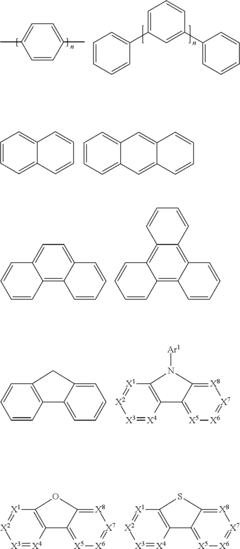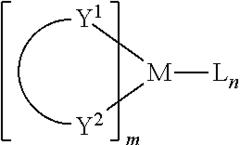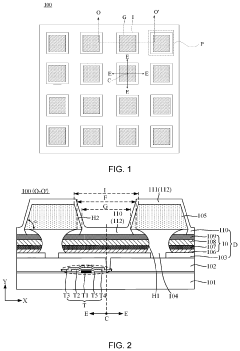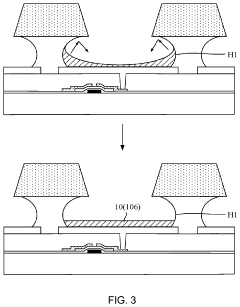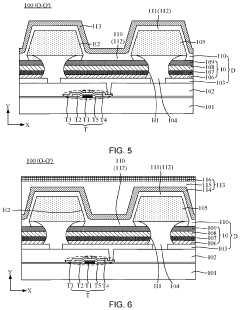Progression of QLED: Understanding Latest Technological Trends
JUN 19, 20259 MIN READ
Generate Your Research Report Instantly with AI Agent
Patsnap Eureka helps you evaluate technical feasibility & market potential.
QLED Evolution and Objectives
Quantum Dot Light-Emitting Diode (QLED) technology has emerged as a revolutionary advancement in display technology, offering superior color performance and energy efficiency compared to traditional LED displays. The evolution of QLED technology can be traced back to the early 2000s when researchers first began exploring the potential of quantum dots in display applications.
The primary objective of QLED development has been to create displays with enhanced color accuracy, brightness, and energy efficiency. As the technology progressed, researchers and manufacturers focused on improving quantum dot synthesis, integration methods, and overall display performance. This ongoing pursuit has led to significant advancements in QLED technology over the past two decades.
One of the key milestones in QLED evolution was the introduction of cadmium-free quantum dots, addressing environmental concerns and regulatory requirements. This development opened up new possibilities for widespread adoption of QLED technology in consumer electronics. Subsequently, efforts were directed towards enhancing the stability and longevity of quantum dots, crucial factors for commercial viability.
The progression of QLED technology has been marked by continuous improvements in color gamut, peak brightness, and power consumption. Researchers have explored various quantum dot materials and structures, including core-shell architectures and perovskite quantum dots, to optimize performance characteristics. These advancements have positioned QLED as a strong competitor to OLED technology in the high-end display market.
Recent trends in QLED development include the pursuit of higher refresh rates, improved viewing angles, and enhanced HDR capabilities. Manufacturers are also focusing on scaling up production processes to reduce costs and increase market penetration. The integration of QLED technology with flexible and transparent display substrates represents another exciting frontier, potentially enabling new form factors and applications.
Looking ahead, the objectives for QLED technology include achieving even higher color purity, improving quantum dot efficiency, and developing novel quantum dot materials. Researchers are also exploring the potential of quantum dot-based micro-LED displays, which could combine the benefits of both technologies. Additionally, there is a growing interest in leveraging QLED technology for next-generation lighting solutions, expanding its applications beyond displays.
As QLED technology continues to mature, industry stakeholders are increasingly focused on sustainability and circular economy principles. This includes developing more environmentally friendly quantum dot materials and improving the recyclability of QLED displays. The ultimate goal is to establish QLED as a dominant display technology that offers unparalleled visual performance while meeting stringent environmental standards.
The primary objective of QLED development has been to create displays with enhanced color accuracy, brightness, and energy efficiency. As the technology progressed, researchers and manufacturers focused on improving quantum dot synthesis, integration methods, and overall display performance. This ongoing pursuit has led to significant advancements in QLED technology over the past two decades.
One of the key milestones in QLED evolution was the introduction of cadmium-free quantum dots, addressing environmental concerns and regulatory requirements. This development opened up new possibilities for widespread adoption of QLED technology in consumer electronics. Subsequently, efforts were directed towards enhancing the stability and longevity of quantum dots, crucial factors for commercial viability.
The progression of QLED technology has been marked by continuous improvements in color gamut, peak brightness, and power consumption. Researchers have explored various quantum dot materials and structures, including core-shell architectures and perovskite quantum dots, to optimize performance characteristics. These advancements have positioned QLED as a strong competitor to OLED technology in the high-end display market.
Recent trends in QLED development include the pursuit of higher refresh rates, improved viewing angles, and enhanced HDR capabilities. Manufacturers are also focusing on scaling up production processes to reduce costs and increase market penetration. The integration of QLED technology with flexible and transparent display substrates represents another exciting frontier, potentially enabling new form factors and applications.
Looking ahead, the objectives for QLED technology include achieving even higher color purity, improving quantum dot efficiency, and developing novel quantum dot materials. Researchers are also exploring the potential of quantum dot-based micro-LED displays, which could combine the benefits of both technologies. Additionally, there is a growing interest in leveraging QLED technology for next-generation lighting solutions, expanding its applications beyond displays.
As QLED technology continues to mature, industry stakeholders are increasingly focused on sustainability and circular economy principles. This includes developing more environmentally friendly quantum dot materials and improving the recyclability of QLED displays. The ultimate goal is to establish QLED as a dominant display technology that offers unparalleled visual performance while meeting stringent environmental standards.
QLED Market Demand Analysis
The QLED (Quantum Dot Light Emitting Diode) market has experienced significant growth in recent years, driven by increasing demand for high-quality displays in various consumer electronics and professional applications. This technology offers superior color performance, brightness, and energy efficiency compared to traditional LED displays, making it particularly attractive in the premium segment of the display market.
In the consumer electronics sector, QLED technology has gained substantial traction, especially in high-end televisions. The demand for larger screen sizes with 4K and 8K resolutions has been a key driver for QLED adoption. Consumers are increasingly seeking immersive viewing experiences with vibrant colors and high contrast ratios, which QLED displays excel at providing. This trend has led to a steady increase in QLED TV sales, with major manufacturers expanding their QLED product lines to cater to this growing demand.
The gaming industry has also emerged as a significant market for QLED displays. Gamers value the technology's ability to deliver high refresh rates, low input lag, and excellent color reproduction, enhancing their gaming experience. As e-sports and competitive gaming continue to grow in popularity, the demand for QLED monitors and gaming-specific displays is expected to rise further.
In the professional sector, QLED technology is finding applications in digital signage, control rooms, and high-end monitors for content creation. The ability of QLED displays to maintain color accuracy and brightness over extended periods makes them ideal for these demanding applications. Industries such as retail, transportation, and healthcare are increasingly adopting QLED displays for their digital signage needs, driving market growth in this segment.
The automotive industry represents another emerging market for QLED technology. As vehicles become more technologically advanced, there is a growing demand for high-quality displays in dashboards, infotainment systems, and rear-seat entertainment units. QLED's superior brightness and color performance make it well-suited for in-vehicle displays, where readability under varying light conditions is crucial.
Market analysts project continued growth for the QLED market in the coming years. Factors contributing to this positive outlook include ongoing technological advancements, decreasing production costs, and expanding applications across various industries. The increasing focus on energy efficiency and environmental sustainability also favors QLED technology, as it offers better power efficiency compared to some alternative display technologies.
However, the QLED market faces competition from other emerging display technologies, such as OLED and MicroLED. While QLED currently holds advantages in certain areas like brightness and lifespan, ongoing developments in competing technologies may impact future market dynamics. Additionally, the global economic climate and supply chain disruptions can influence market growth and adoption rates in the short to medium term.
In the consumer electronics sector, QLED technology has gained substantial traction, especially in high-end televisions. The demand for larger screen sizes with 4K and 8K resolutions has been a key driver for QLED adoption. Consumers are increasingly seeking immersive viewing experiences with vibrant colors and high contrast ratios, which QLED displays excel at providing. This trend has led to a steady increase in QLED TV sales, with major manufacturers expanding their QLED product lines to cater to this growing demand.
The gaming industry has also emerged as a significant market for QLED displays. Gamers value the technology's ability to deliver high refresh rates, low input lag, and excellent color reproduction, enhancing their gaming experience. As e-sports and competitive gaming continue to grow in popularity, the demand for QLED monitors and gaming-specific displays is expected to rise further.
In the professional sector, QLED technology is finding applications in digital signage, control rooms, and high-end monitors for content creation. The ability of QLED displays to maintain color accuracy and brightness over extended periods makes them ideal for these demanding applications. Industries such as retail, transportation, and healthcare are increasingly adopting QLED displays for their digital signage needs, driving market growth in this segment.
The automotive industry represents another emerging market for QLED technology. As vehicles become more technologically advanced, there is a growing demand for high-quality displays in dashboards, infotainment systems, and rear-seat entertainment units. QLED's superior brightness and color performance make it well-suited for in-vehicle displays, where readability under varying light conditions is crucial.
Market analysts project continued growth for the QLED market in the coming years. Factors contributing to this positive outlook include ongoing technological advancements, decreasing production costs, and expanding applications across various industries. The increasing focus on energy efficiency and environmental sustainability also favors QLED technology, as it offers better power efficiency compared to some alternative display technologies.
However, the QLED market faces competition from other emerging display technologies, such as OLED and MicroLED. While QLED currently holds advantages in certain areas like brightness and lifespan, ongoing developments in competing technologies may impact future market dynamics. Additionally, the global economic climate and supply chain disruptions can influence market growth and adoption rates in the short to medium term.
QLED Tech Status and Hurdles
QLED (Quantum Dot Light Emitting Diode) technology has made significant strides in recent years, revolutionizing the display industry. However, despite its rapid progress, QLED still faces several technological challenges that need to be addressed for further advancement.
One of the primary hurdles in QLED technology is the stability and longevity of quantum dots. While these nanocrystals offer exceptional color purity and brightness, they are susceptible to degradation over time, particularly when exposed to high temperatures and moisture. This degradation can lead to color shifts and reduced overall performance of QLED displays.
Another significant challenge lies in the blue quantum dot efficiency. Blue quantum dots typically have lower quantum yields compared to their red and green counterparts, resulting in higher energy consumption and potential color imbalance in displays. Improving the efficiency of blue quantum dots remains a key focus area for researchers and manufacturers alike.
The manufacturing process of QLED displays also presents challenges. Achieving uniform deposition of quantum dots across large areas while maintaining precise control over their size and distribution is crucial for consistent display quality. Current manufacturing techniques still struggle to meet these requirements at scale, impacting production yields and costs.
Environmental concerns surrounding the use of cadmium in some quantum dot formulations have led to increased research into cadmium-free alternatives. While progress has been made in developing indium-based quantum dots, these alternatives often fall short in terms of color performance and stability compared to their cadmium-based counterparts.
The integration of quantum dots with other display technologies, such as OLED (Organic Light Emitting Diode), presents both opportunities and challenges. Hybrid QLED-OLED displays aim to combine the strengths of both technologies, but achieving seamless integration and optimizing performance remains a complex task.
In terms of technological status, QLED displays have gained significant market share in the premium TV segment, competing directly with OLED technology. Major manufacturers like Samsung, TCL, and Hisense have invested heavily in QLED development, driving continuous improvements in picture quality, color gamut, and energy efficiency.
Geographically, South Korea and China lead in QLED research and production, with significant contributions also coming from the United States and Europe. The global competition in QLED technology has intensified, spurring innovation and accelerating the pace of technological advancements in this field.
One of the primary hurdles in QLED technology is the stability and longevity of quantum dots. While these nanocrystals offer exceptional color purity and brightness, they are susceptible to degradation over time, particularly when exposed to high temperatures and moisture. This degradation can lead to color shifts and reduced overall performance of QLED displays.
Another significant challenge lies in the blue quantum dot efficiency. Blue quantum dots typically have lower quantum yields compared to their red and green counterparts, resulting in higher energy consumption and potential color imbalance in displays. Improving the efficiency of blue quantum dots remains a key focus area for researchers and manufacturers alike.
The manufacturing process of QLED displays also presents challenges. Achieving uniform deposition of quantum dots across large areas while maintaining precise control over their size and distribution is crucial for consistent display quality. Current manufacturing techniques still struggle to meet these requirements at scale, impacting production yields and costs.
Environmental concerns surrounding the use of cadmium in some quantum dot formulations have led to increased research into cadmium-free alternatives. While progress has been made in developing indium-based quantum dots, these alternatives often fall short in terms of color performance and stability compared to their cadmium-based counterparts.
The integration of quantum dots with other display technologies, such as OLED (Organic Light Emitting Diode), presents both opportunities and challenges. Hybrid QLED-OLED displays aim to combine the strengths of both technologies, but achieving seamless integration and optimizing performance remains a complex task.
In terms of technological status, QLED displays have gained significant market share in the premium TV segment, competing directly with OLED technology. Major manufacturers like Samsung, TCL, and Hisense have invested heavily in QLED development, driving continuous improvements in picture quality, color gamut, and energy efficiency.
Geographically, South Korea and China lead in QLED research and production, with significant contributions also coming from the United States and Europe. The global competition in QLED technology has intensified, spurring innovation and accelerating the pace of technological advancements in this field.
Current QLED Solutions
01 Quantum dot structure optimization
Improving QLED performance through optimizing the structure of quantum dots. This includes enhancing the core-shell structure, adjusting the size and composition of quantum dots, and developing new quantum dot materials to improve light emission efficiency and color purity.- Quantum dot composition and structure: The performance of QLED devices is significantly influenced by the composition and structure of quantum dots. Researchers focus on optimizing the core-shell structure, exploring various materials for the core and shell, and fine-tuning the size and shape of quantum dots to enhance light emission efficiency and color purity.
- Quantum dot light-emitting layer design: The design of the quantum dot light-emitting layer plays a crucial role in QLED performance. This includes developing novel deposition techniques, optimizing layer thickness, and improving the uniformity of quantum dot distribution to achieve better luminescence and device stability.
- Charge transport layer optimization: Enhancing the performance of charge transport layers in QLED devices is essential for improving overall efficiency. This involves developing new materials for electron and hole transport layers, optimizing layer thicknesses, and engineering energy level alignment to facilitate efficient charge injection and transport.
- QLED device architecture and fabrication: Innovations in QLED device architecture and fabrication processes contribute to performance improvements. This includes developing novel device structures, exploring new electrode materials, and optimizing manufacturing techniques to enhance device efficiency, stability, and lifetime.
- Color tuning and light management: Achieving precise color control and efficient light extraction are critical aspects of QLED performance. Researchers focus on developing color conversion layers, optimizing quantum dot mixtures for white light emission, and implementing light management strategies to improve color gamut and overall device efficiency.
02 Light-emitting layer design
Enhancing QLED performance by optimizing the light-emitting layer design. This involves improving the quantum dot arrangement, developing novel deposition techniques, and incorporating additional functional layers to enhance charge injection and transport.Expand Specific Solutions03 Electrode and charge transport layer improvements
Boosting QLED efficiency through advancements in electrode materials and charge transport layers. This includes developing transparent conductive electrodes, enhancing hole and electron transport layers, and optimizing the interface between different layers to reduce energy barriers.Expand Specific Solutions04 Color conversion and light management
Improving QLED performance by enhancing color conversion efficiency and light management. This involves developing advanced color filters, implementing light extraction techniques, and optimizing the device structure to maximize light output and color gamut.Expand Specific Solutions05 Stability and lifetime enhancement
Increasing QLED longevity and stability through various approaches. This includes developing encapsulation techniques, improving the resistance to environmental factors, and implementing strategies to mitigate degradation mechanisms in quantum dots and other device components.Expand Specific Solutions
QLED Industry Leaders
The QLED technology market is in a growth phase, with increasing adoption and continuous innovation. The market size is expanding rapidly, driven by demand for high-quality displays in various applications. Technologically, QLED is maturing but still evolving, with companies like BOE Technology Group, TCL China Star Optoelectronics, and Sharp Corp. leading the way. These firms are investing heavily in R&D to improve color accuracy, brightness, and energy efficiency. Emerging players such as Guangdong Juhua Printing Display Technology and Hefei Visionox Technology are also contributing to advancements. The competitive landscape is characterized by a mix of established display manufacturers and innovative startups, all vying to capture market share in this promising field.
BOE Technology Group Co., Ltd.
Technical Solution: BOE has made significant strides in QLED technology, focusing on improving color gamut, brightness, and energy efficiency. Their latest QLED displays utilize quantum dot enhancement film (QDEF) technology, which allows for a wider color gamut and higher peak brightness. BOE has also developed advanced local dimming techniques to enhance contrast ratios and reduce power consumption. Their QLED panels incorporate a new generation of quantum dots with improved stability and longevity, addressing previous concerns about QLED lifespan.
Strengths: Wide color gamut, high brightness, and improved energy efficiency. Weaknesses: Higher production costs compared to traditional LED displays, and potential for image retention in static content scenarios.
Shenzhen China Star Optoelectronics Semicon Display Tech Co.
Technical Solution: CSOT has developed a proprietary QLED technology called Q-Light, which focuses on enhancing color accuracy and brightness while reducing power consumption. Their latest QLED displays feature an advanced quantum dot composition that allows for more precise color control and a wider color gamut. CSOT has also implemented a unique backlight structure that improves light distribution and reduces color shift at wide viewing angles. Additionally, they have integrated AI-driven image processing algorithms to optimize picture quality in real-time based on content and ambient lighting conditions.
Strengths: Excellent color accuracy, wide viewing angles, and AI-enhanced picture quality. Weaknesses: Relatively new to the QLED market, which may result in less brand recognition compared to more established competitors.
Key QLED Innovations
Display component and manufacturing method therefor
PatentInactiveUS20180130853A1
Innovation
- A composite printed display device comprising red, green, and blue sub-pixels, where the green sub-pixel uses organic light-emitting material and either or both red and blue sub-pixels use colloidal quantum dot light-emitting material, all prepared by printing methods like ink-jet, gravure, or nano imprinting, with shared hole injection/transport layers and electron layers optimized for high performance and cost-effectiveness.
Display substrate and method for manufacturing the same, and display apparatus
PatentPendingUS20240224598A1
Innovation
- A display substrate design with recessed sidewalls in the first openings and inclined second openings, combined with lyophobic and lyophilic layers, guides the ink to form a light-emitting functional layer with uniform thickness, preventing ink climbing and bridging, and enhancing light-emitting performance.
QLED vs. OLED Comparison
QLED (Quantum Dot Light Emitting Diode) and OLED (Organic Light Emitting Diode) are two leading display technologies that have been competing for dominance in the high-end television and display market. Both offer superior picture quality compared to traditional LED-LCD displays, but they achieve this through different mechanisms and have distinct advantages and disadvantages.
QLED technology, pioneered by Samsung, uses a layer of quantum dots to enhance the color and brightness of LED-backlit LCD screens. These quantum dots are tiny semiconductor particles that emit light of specific wavelengths when excited by electricity. This results in more vibrant and accurate colors, as well as improved brightness levels. QLED displays can achieve higher peak brightness than OLED, making them particularly suitable for well-lit environments.
On the other hand, OLED technology, championed by LG, uses organic compounds that emit light when an electric current is applied. Each pixel in an OLED display is self-emissive, meaning it can turn on and off independently. This allows for perfect blacks and infinite contrast ratios, as pixels can be completely turned off when displaying black. OLED displays also offer wider viewing angles and faster response times compared to QLED.
In terms of lifespan and burn-in resistance, QLED displays generally have an advantage. The inorganic nature of quantum dots makes them more stable over time, reducing the risk of image retention or burn-in that can affect OLED displays. However, recent advancements in OLED technology have significantly mitigated these issues.
Energy efficiency is another area of comparison. OLED displays tend to be more energy-efficient overall, especially when displaying darker content, as they can turn off individual pixels. QLED displays, while improving in efficiency, still require a backlight that consumes energy even when displaying dark scenes.
Manufacturing costs and scalability also differ between the two technologies. QLED displays are generally less expensive to produce at larger sizes, which has contributed to their popularity in the large-screen TV market. OLED manufacturing, while becoming more cost-effective, still faces challenges in producing very large screens economically.
As both technologies continue to evolve, the gap in performance is narrowing. QLED displays are improving in terms of contrast and viewing angles, while OLED displays are becoming brighter and more resistant to burn-in. The choice between QLED and OLED often comes down to specific use cases and personal preferences, with each technology excelling in different areas.
QLED technology, pioneered by Samsung, uses a layer of quantum dots to enhance the color and brightness of LED-backlit LCD screens. These quantum dots are tiny semiconductor particles that emit light of specific wavelengths when excited by electricity. This results in more vibrant and accurate colors, as well as improved brightness levels. QLED displays can achieve higher peak brightness than OLED, making them particularly suitable for well-lit environments.
On the other hand, OLED technology, championed by LG, uses organic compounds that emit light when an electric current is applied. Each pixel in an OLED display is self-emissive, meaning it can turn on and off independently. This allows for perfect blacks and infinite contrast ratios, as pixels can be completely turned off when displaying black. OLED displays also offer wider viewing angles and faster response times compared to QLED.
In terms of lifespan and burn-in resistance, QLED displays generally have an advantage. The inorganic nature of quantum dots makes them more stable over time, reducing the risk of image retention or burn-in that can affect OLED displays. However, recent advancements in OLED technology have significantly mitigated these issues.
Energy efficiency is another area of comparison. OLED displays tend to be more energy-efficient overall, especially when displaying darker content, as they can turn off individual pixels. QLED displays, while improving in efficiency, still require a backlight that consumes energy even when displaying dark scenes.
Manufacturing costs and scalability also differ between the two technologies. QLED displays are generally less expensive to produce at larger sizes, which has contributed to their popularity in the large-screen TV market. OLED manufacturing, while becoming more cost-effective, still faces challenges in producing very large screens economically.
As both technologies continue to evolve, the gap in performance is narrowing. QLED displays are improving in terms of contrast and viewing angles, while OLED displays are becoming brighter and more resistant to burn-in. The choice between QLED and OLED often comes down to specific use cases and personal preferences, with each technology excelling in different areas.
QLED Environmental Impact
The environmental impact of QLED (Quantum Dot Light Emitting Diode) technology has become an increasingly important consideration as this display technology continues to evolve and gain market share. As QLED progresses, manufacturers and researchers are focusing on developing more sustainable and eco-friendly production processes and materials.
One of the primary environmental concerns associated with QLED technology is the use of cadmium in some quantum dot formulations. Cadmium is a toxic heavy metal that can pose risks to human health and the environment if not properly managed. However, recent advancements have led to the development of cadmium-free quantum dots, which significantly reduce the environmental impact of QLED displays.
Energy efficiency is another crucial aspect of QLED's environmental impact. Compared to traditional LCD displays, QLEDs offer improved energy efficiency due to their ability to produce brighter and more vibrant colors with less power consumption. This increased efficiency translates to lower energy usage over the lifetime of the display, potentially reducing the carbon footprint associated with electronic devices.
The manufacturing process of QLED displays has also been subject to environmental scrutiny. Efforts are being made to optimize production techniques to minimize waste and reduce the use of harmful chemicals. Additionally, research is ongoing to develop more sustainable materials for quantum dot synthesis and display components.
Recycling and end-of-life management of QLED displays present both challenges and opportunities. The complex nature of these displays, with their multiple layers and specialized materials, can make recycling difficult. However, as the technology matures, improved recycling methods are being developed to recover valuable materials and reduce electronic waste.
Water usage in QLED production is another environmental consideration. Manufacturers are implementing water conservation measures and exploring ways to reduce water consumption in the fabrication of quantum dots and display panels. This includes the development of more efficient cleaning processes and the implementation of water recycling systems in production facilities.
As QLED technology continues to advance, there is a growing focus on lifecycle assessment to understand and mitigate the environmental impact at every stage of production, use, and disposal. This holistic approach is driving innovation in materials science, manufacturing processes, and recycling technologies, aiming to make QLED displays more environmentally sustainable in the long term.
One of the primary environmental concerns associated with QLED technology is the use of cadmium in some quantum dot formulations. Cadmium is a toxic heavy metal that can pose risks to human health and the environment if not properly managed. However, recent advancements have led to the development of cadmium-free quantum dots, which significantly reduce the environmental impact of QLED displays.
Energy efficiency is another crucial aspect of QLED's environmental impact. Compared to traditional LCD displays, QLEDs offer improved energy efficiency due to their ability to produce brighter and more vibrant colors with less power consumption. This increased efficiency translates to lower energy usage over the lifetime of the display, potentially reducing the carbon footprint associated with electronic devices.
The manufacturing process of QLED displays has also been subject to environmental scrutiny. Efforts are being made to optimize production techniques to minimize waste and reduce the use of harmful chemicals. Additionally, research is ongoing to develop more sustainable materials for quantum dot synthesis and display components.
Recycling and end-of-life management of QLED displays present both challenges and opportunities. The complex nature of these displays, with their multiple layers and specialized materials, can make recycling difficult. However, as the technology matures, improved recycling methods are being developed to recover valuable materials and reduce electronic waste.
Water usage in QLED production is another environmental consideration. Manufacturers are implementing water conservation measures and exploring ways to reduce water consumption in the fabrication of quantum dots and display panels. This includes the development of more efficient cleaning processes and the implementation of water recycling systems in production facilities.
As QLED technology continues to advance, there is a growing focus on lifecycle assessment to understand and mitigate the environmental impact at every stage of production, use, and disposal. This holistic approach is driving innovation in materials science, manufacturing processes, and recycling technologies, aiming to make QLED displays more environmentally sustainable in the long term.
Unlock deeper insights with Patsnap Eureka Quick Research — get a full tech report to explore trends and direct your research. Try now!
Generate Your Research Report Instantly with AI Agent
Supercharge your innovation with Patsnap Eureka AI Agent Platform!

